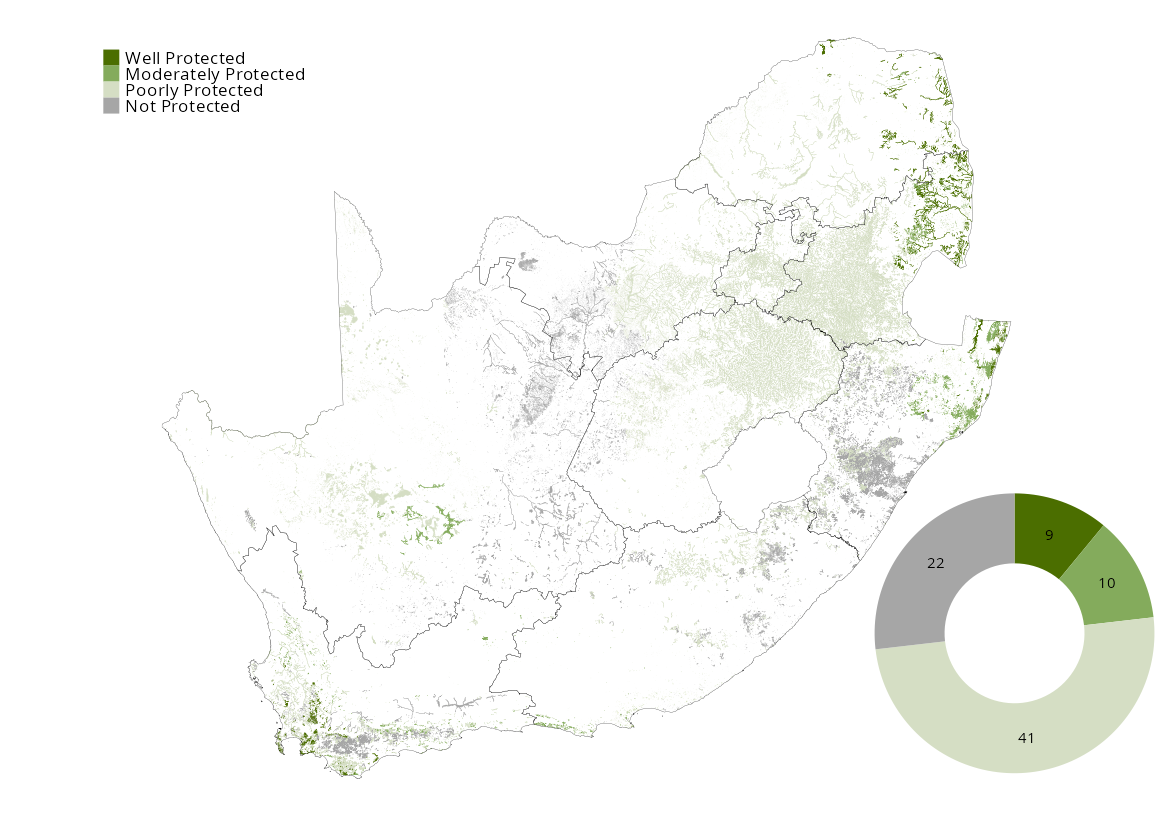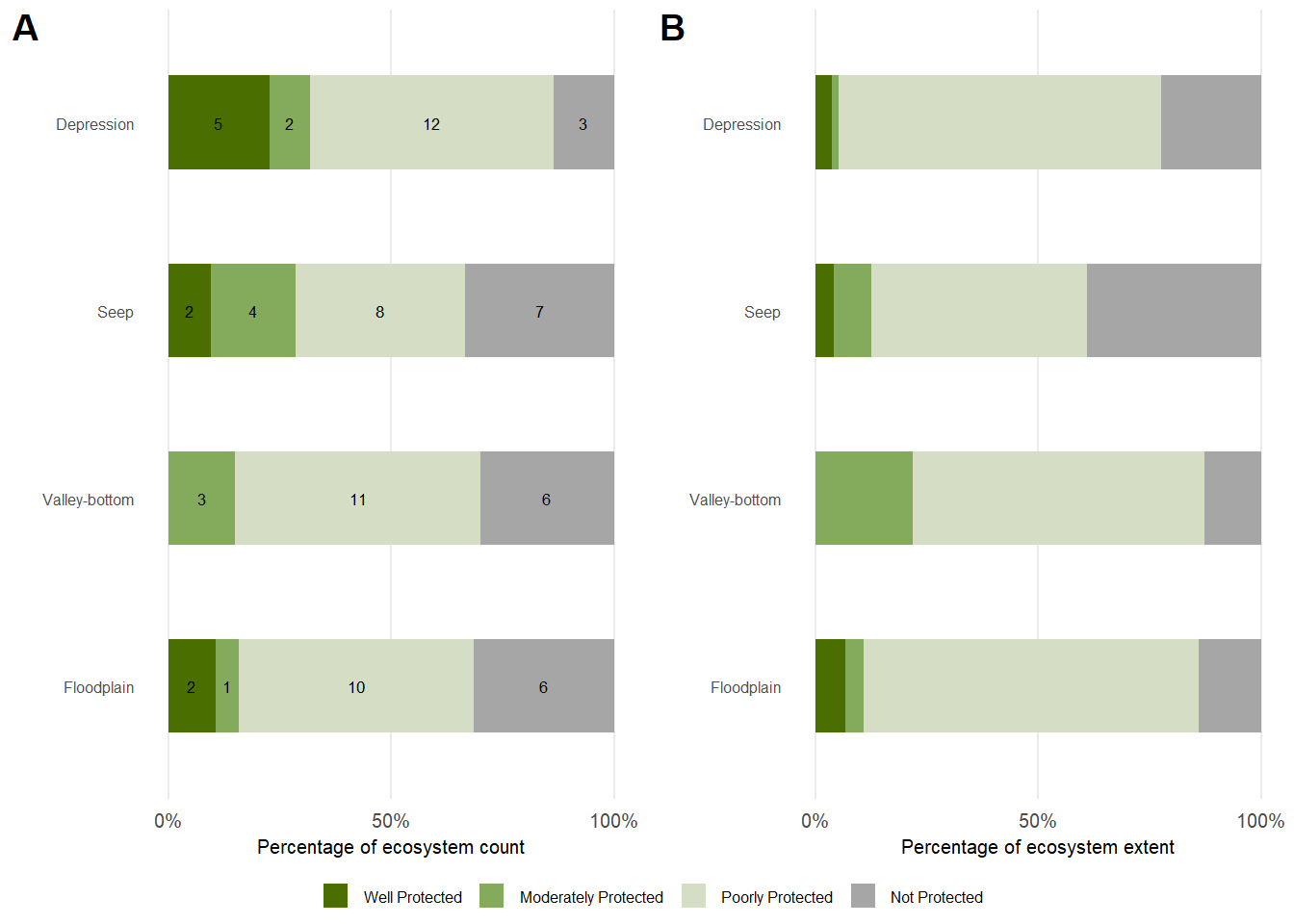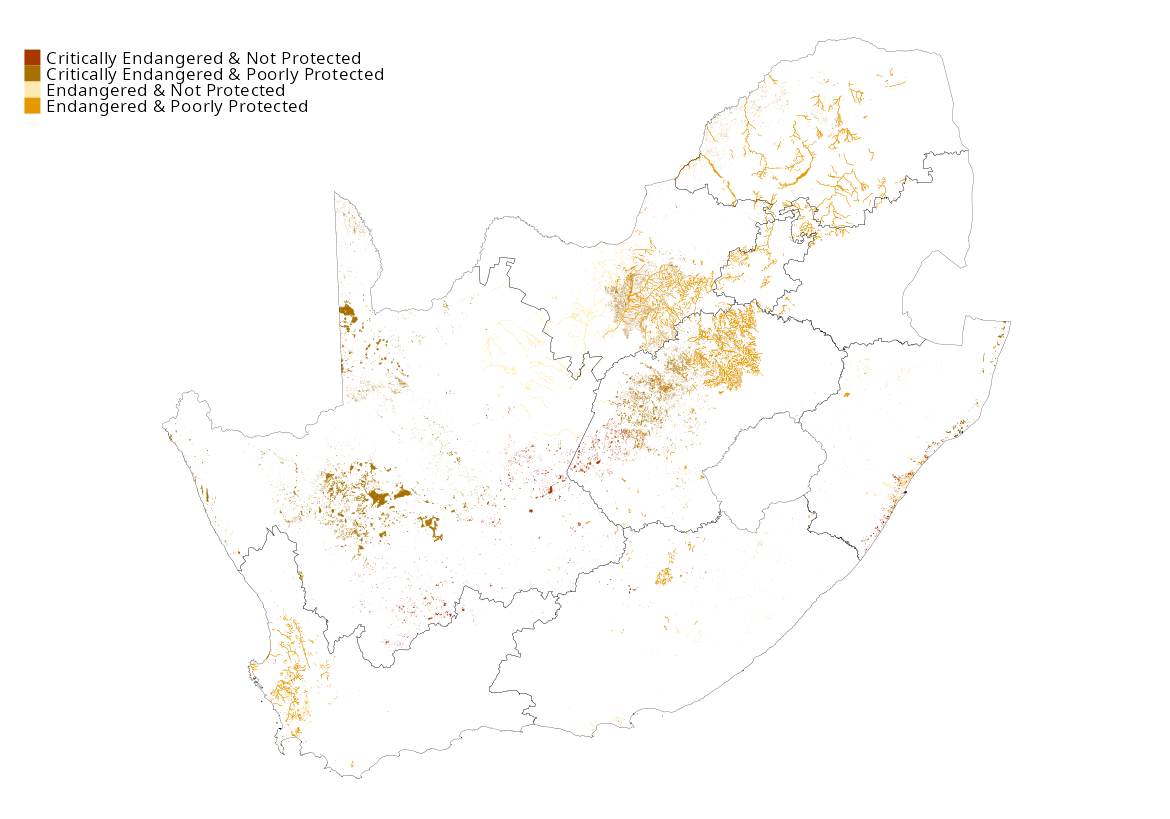Protected Areas play an important role in conserving representative and healthy functioning wetland ecosystems to ensure the continued existence of species and ecosystem types. However, inland wetland types are severely under-represented and under-protected in South Africa, with nearly 80% of wetland ecosystem types categorised as Poorly Protected or Not Protected.This is driven in part by poor ecosystem condition, as only intact or moderately modified ecosystem extent contributes fully to the ecosystem target.
Add landscape photo. Umgeni Vlei Provincial Nature Reserve and Ramsar site, KwaZulu-Natal (Ⓒ xxxx)
of 82 inland wetland types
Well Protected
of wetland extent
Well Protected
The proportion of South Africa’s total wetland extent under statutory protection (i.e. in categories1 recognised under the Protected Areas Act) at the time of this assessment is x% (930 000 km2). Taking wetland ecological condition into consideration, approximately 5% of inland wetland ecosystem extent is Well Protected, 6% is Moderately Protected, 69% is Poorly Protected and 20% is Not Protected.
According to wetland type, 8 (10%) of inland wetland ecosystem types are Well Protected, 11 (13%) are Moderately Protected, 41 (50%) are Poorly Protected and 22 (27%) are Not Protected. Well Protected wetland ecosystem types are clustered within the Kruger National Park in eastern Mpumalanga, iSimangaliso Wetland Park World Heritage Site on the Maputaland Coastal Plain in KwaZulu-Natal, and across the Western Cape. Well Protected wetland ecosystem types are clustered within the Kruger National Park in eastern Mpumalanga, iSimangaliso Wetland Park World Heritage Site on the Maputaland Coastal Plain in KwaZulu-Natal, and across the Western Cape.

In terms of wetland hydrogeomorphic type,depression wetlands have the highest protection level, with 33% of depression wetland types and 37% of depression wetland extent considered to be Well Protected, while only 11% and 10% respectively of floodplain and seep wetland types are considered Well Protected. No unchannelled valley-bottom wetland types are considered to be Well Protected.

| Well Protected | Moderately Protected | Poorly Protected | Not Protected | ||
|---|---|---|---|---|---|
| Depression | Count | 5 | 2 | 12 | 3 |
| Extent (km2) | 277 | 115 | 5 548 | 1 714 | |
| Seep | Count | 2 | 4 | 8 | 7 |
| Extent (km2) | 203 | 423 | 2 393 | 1 935 | |
| Unchannelled valley-bottom | Count | 0 | 3 | 11 | 6 |
| Extent (km2) | 0 | 786 | 2 338 | 457 | |
| Floodplain | Count | 2 | 1 | 10 | 6 |
| Extent (km2) | 928 | 560 | 10 316 | 1 914 | |
Download the data here.
Although there has been positive progress in protecting inland wetland ecosystem types, the national protected area network could be strengthened to encompass a wider representation of South Africa’s inland wetlands and to afford protection to those that are Poorly Protected or Not Protected. Seventeen (20%) out of 82 inland wetland types are both threatened (i.e. Critically Endangered, Endangered or Vulnerable) and under-protected (Not Protected). They are found on the Highveld, along the eastern escarpment, in the Cape Fold Mountains and the arid Northern Cape.

Note that the current wetland ecosystem protection level analysis is built on a robust interim wetland ecosystem typology and an automated WetHealth Level 1 applied at national scale for the first time. However, to ensure the most robust and defensible characterisation of wetland types, the National Wetland Map team is actively refining the typology into more detailed, validated subtypes in collaboration with multiple specialist researchers. This work is ongoing and may result in minor adjustments to wetland types and ecological condition, and an updated assessment in the near future.
Approach to assess this indicator
Ecosystem Protection Level [Harris et al. (in review)] measures the degree to which South Africa’s inland wetland ecosystem types are represented within the protected area [SA govt] network. While previous NBA assessments used a standard 20% target [Roux et al], the current protection level target was adjusted in line with Target 3 of the Global Biodiversity Framework, to assess whether 30% of each of the 82 inland wetland ecosystem types falls within a Protected Area [SAPAD].
Importantly, the current condition of the wetland is also taken into consideration in the calculation2. At least 30% of each wetland ecosystem type (i.e. the ecosystem target) needs to be in a natural or near natural ecological condition (ecological class A or B) to qualify in the Well Protected category. If this target was not met, the ecosystem was categorised as Moderately Protected.
The four ecosystem protection level indicator classes were calculated as follows: Well Protected: 100% of an inland wetland ecosystem type’s target falls within the Protected Area network; but only wetlands in an A and B condition are considered to contribute; Moderately Protected: 50% to 99% of an inland wetland ecosystem type’s target falls within the Protected Area network; and wetlands in an A and B condition contribute 100%, wetlands in a C and D condition contribute 30%, while E and F condition wetlands contribute only 10%; Poorly Protected: 5% to 49% of an inland wetland ecosystem type’s target falls within the Protected Area network; and A and B condition wetlands contribute 100%, C and D condition wetlands contribute 30%, E and F condition wetlands contribute 10%; Not Protected: less than 5% of a wetland ecosystem type’s target falls within the Protected Area network; and A and B condition wetlands contribute 100%, C and D condition wetlands contribute 30%, E and F condition wetlands contribute 10%.
Note that changes in the results since NBA 2018 reflect modest changes in ecosystem protection level, but are also due to expanded wetland mapping efforts and revised targets and methods to improve alignment globally and among realms in South Africa. In terms of the two key input layers for calculating ecosystem protection level, wetland ecological condition will continue to be reviewed against field-validated WetHealth specialist assessments, and updates to wetland ecosystem type is in process This will continue to be an exciting space for progress in the upcoming years. New results will be posted to this web page at key intervals and communicated to the field of practice. Application of the NBA wetland datasets in EIAs should always be supported by a specialist field assessment and, ideally, fed back to the National Wetland Map team to support the calibration of these datasets.
Acknowledgements
Reviewers of this web page xx
Technical documentation
Code repository: https://github.com/askowno/EPL_wetl
Key Publications:
Harris, L.R., Skowno, A.L., Holness, S.D., Sink, K.J., van Niekerk, L., van Deventer, H., Smith-Adao, L., Job, N., Khatieb, S., Monyeki, M. Indicators for tracking progress in effective, representative ecosystem protection. Conservation Biology, in review. Technical details regarding development of new indicators of effective, representative ecosystem protection and their application in South Africa.
Technical reports:
Recommended citation
Job, N.M., Skowno, A.L xx. 2025. Ecosystem protection level: Freshwater (inland aquatic) realm synthesis. National Biodiversity Assessment 2025. South African National Biodiversity Institute. http://nba.sanbi.org.za/.